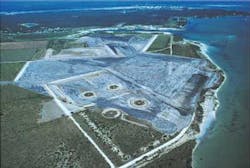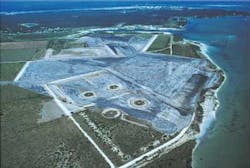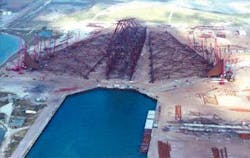GULF OF MEXICO: Three adjacent Gulf of Mexico fab yards aim at new deepwater units
In recent years, the CSO Gulf Marine Fabricators facility in Ingleside, Texas, has been the site of a number of high-profile fabrication, integration, and assembly projects, but the yard will soon have competition coming at it from both sides, literally.
As Gulf of Mexico deepwater field development activity picks up, a new round of fabrication yard openings is underway. In addition to existing projects that need fabrication work, these facilities are banking on floating production, storage, and offloading (FPSO) vessels being permitted for US Gulf of Mexico operation. In addition, other structures, such as Spars and deep-draft tensioned vessels, are also being considered for new deepwater fields.
CSO Gulf Marine Fabricators is located on the Corpus Christi Ship Channel, about 10 miles inland from the Gulf of Mexico. The yard has unobstructed access to deepwater and has been the launch site for a number of varied projects, including the Bald Pate compliant tower, the Neptune, Genesis, and Hoover/Diana Spars, the Mars and Brutus tension leg platforms (TLP), and two fifth-generation drillships.
With its deepwater quayside and convenient access to fields in the deepwater Gulf of Mexico, the yard in Ingleside seems to have a prime location. So good, in fact, that it is attracting a lot of competition. J. Ray McDermott has begun re-opening the Harbor Island yard, five miles from Gulf Marine and closer to the Gulf of Mexico. Kiewit Offshore Services is nearing the completion of the third fabrication facility within site of Gulf Marine, further up the Ship Channel. Will there be enough work for these three yards?
Yard by acquisition
While an increase in business seems to be the prime driver for the new yard openings, there are other factors involved. For example, the CSO Gulf Marine Fabricators yard is now owned wholly by Aker, which was recently acquired by Coflexip Stena Offshore (CSO). Partner Kiewit Offshore Services accepted a buyout and took dozens of managers with it to open the new yard just up the road.
In the meantime, the Harbor Island yard, owned by J. Ray McDermott, and opened back in the mid 1970s, is showing signs of life for the first time in five years. McDermott closed the yard in the mid 1990s, but is in the process of staffing up and re-activating the property. Ironically, this deal also has something to do with the sale of Aker.
Aker and McDermott dissolved their Spars International partnership last year, which was supplying the Spar work to the Gulf Marine Fabricators yard. Now, as McDermott secures Spar contracts through its new SparTec company, it needs a facility to do the assembly and topside work. Harbor Island was a natural choice.
Re-opening facility
Slightly larger than CSO Gulf Marine Fabricators, McDermott's Harbor Island facility has many of the same advantages. It has clear access to the 45-ft deep Corpus Christi Ship Channel and is even closer than Gulf Marine Fabricators to the Gulf of Mexico. - The south yard of CSO Gulf Marine Fabrication features specialized lifting devices.
Since its announcement that the yard is being reopened, J. Ray McDermott has secured two Spar contracts to be assembled at this yard. McDermott will assemble the topsides for Murphy Oil's Medusa Spar and Dominion's Devils Tower. The Spar hulls will not be fabricated at Harbor Island, but the topsides will be built there from sub-assemblies constructed at McDermott's TNG yard in Veracruz, Mexico. The Spar hulls will be built at other McDermott facilities.
The hull for Medusa is being fabricated at the Jebel Ali yard in the UAE, and the Devils Tower hull will be fabricated at the company's Batam Island yard in Indonesia. Access to several facilities around the world gives McDermott a lot of flexibility when bidding on EPCI projects, according to Billy Cash, Director for Group Marketing, with J. Ray McDermott.
Finding skilled workers
One of the main challenges, with several yards ramping up at the same time, is finding skilled workers. While numbers vary, press reports state the Harbor Island yard will employ 250 skilled workers.
To ensure access to such a work force, McDermott has established a strategic alliance with Bay Ltd. of Corpus Christi, Texas. Bay will provide the yard with outfitting fabrication and construction services as well as skilled labor and support equipment. While the two topsides-assembly projects will be staggered, Cash said that much of the work will be going on concurrently.
Cash said the 283-acre facility is large enough to accommodate the two projects, and will have enough equipment to handle them. In fact, the yard will be pursuing other projects for the same time frame. Because the entire yard is being reactivated at one time, rather than in phases, there will be space for several ongoing activities. Although the two Spar projects are large, the yard still has available capacity.
In addition to Spars, Cash said McDermott is interested in fabricating deep-bottom founded structures such as compliant towers and large jackets. Because it has a deepwater quayside, the yard can perform topside integration on FPSO vessels as well. This may become a critical capability if such vessels are introduced into the Gulf of Mexico.
Since the yard re-opened last November, work has been underway preparing for the Spar projects and other projects pending. Preparation includes lining up the necessary contractors, facility restoration, supplies, and of course, staffing the yard.
Cash said he doesn't have any firm numbers on how many employees will work at the yard initially, or how many of these will be new hires, but it is clear that Bay will play a key role in supplying construction services on a project basis. Work on Medusa, the first project for the yard, will begin this November as the topside modules arrive from Mexico.
As far as the market for assembly work is concerned, Cash said the estimates he has seen show there should be plenty of work to fill the capacity of the yard. He stopped short of commenting on the competing facilities right up the ship channel. With more deepwater developments scheduled to come on line in the Gulf of Mexico, this location is in a prime position to compete for a variety of work, he said.
While there was quite a lot of yard expansion going on during the mini-boom of the mid-1990s, Cash said Harbor Island will not fall into the same trap that led many of those yards to consolidate or close. Cash said the Harbor Island facility has two advantages over the troubled yards on other parts of the Gulf coast. "We have a better location and more resources," he said.
Changes at GMF
The Gulf Marine Fabricators yard was originally owned outright by Peter Kiewit Offshore Services (KOS). In 1993, during a lull in Gulf of Mexico offshore activity, 51% of the yard was sold to Aker. This gave the yard some working cash and a partner to spread out the risk. The yard continued operating this way through the 1990s.
Then, last year, a move was made to consolidate ownership. Aker decided to act as buyer, taking over 100% of the yard ownership. Of 35 KOS stockholders on the staff, Brinson Miles, President of Gulf Marine Fabricators, said 33 left to form a new, competing yard. This left Gulf Marine Fabricators in a precarious position.
Virtually the entire management team was gone and the yard had a number of high-dollar, high-profile projects underway. Aker had to react quickly in evaluating the employees it had left. In January of this year, Gulf Marine Fabricators became part of the Coflexip Stena Offshore Group when CSO acquired Aker Maritime's Deepwater Division.
While choosing replacement workers to fill the management positions was a challenge, Miles said the crew now in place has a very positive attitude. Many of the problems the yard had in the past are being resolved and he is confident going forward. Miles said that more important than his opinion was that of the facility's customers. He said that Shell was happy with the turn-around time on the Brutus TLP. The topsides and hull were integrated at the CSO Gulf Marine Fabricators yard, and Miles said this project was completed faster than either of the two previous Shell TLP integrations conducted at the yard.
In addition to a new management team, Miles said the yard has revamped its specialized lifting device (SLD) cranes to ensure they can perform up to capacity. These cranes, along with 16 crawler cranes, provide an advantage for the yard, according to Miles. The cranes can perform integration of larger components. This allows the smaller sub-assemblies to be integrated and commissioned on the ground, before they are installed on a vessel. The less work that has to be done on the vessel, the more time and money can be saved.
Work for all three
While activity is in a seasonal lull, Miles said there is a lot of work coming up for the yard. BP has two truss-Spar designs scheduled for the Gulf of Mexico on the Mad Dog and Holstein fields. These Spars are a new design with a shorter hard can and a long lattice skirt below. The hard can will be constructed at a yard overseas before being shipped to CSO Gulf Marine Fabricators for integration with the truss sections, which will be built by Gulf Marine.
Miles said the strategic location of the yard makes it an assembly and launching point for major Gulf of Mexico deepwater projects. He predicts this pattern of building hulls overseas and doing the topsides and integration work along the Gulf coast will continue. In addition to the two truss Spars on contract, Miles said the yard is bidding on a lot of work. He predicts a period over the next two years when the Gulf Marine yard and the other two being opened will be working at capacity. "It should get like that next year," he said. This work will come not only from the Gulf of Mexico but also the increasingly active fields offshore West Africa.
FPSOs in the Gulf
Beyond the contracted work for these fabrication yards, Miles said there is a lot of speculation about FPSOs permitted for US operations in the deepwater Gulf of Mexico. If they are approved to operate there, as it appears they will be, it could mean a lot of topsides and integration work for Gulf Coast yards. Miles said his 212-acre yard could assemble super sections of FPSO topsides. These topsides are typically made up of as many as 16 regular-size modules.
Integrating and commissioning some of these modules onshore before the FPSO hull arrives at quayside could easily reduce this number to seven. Installing and integrating seven larger modules is much more efficient, according to Miles. The key component in this strategy is the yard's heavy lifting capacity, since the super-modules will weigh substantially more than a typical module.
Still, this work is speculative, but if FPSOs do come into the Gulf of Mexico, it is a good bet the vessels will be newbuilds, with the hulls being constructed overseas and topsides built locally. If this happens it could provide work for a number of yards, Miles said. "People see the FPSO market coming ellipse there is going to be a bunch of them built," he said.
Regardless of crane capacity, one requirement for FPSO work would be deepwater access, which all three yards will have. According to Miles, the US Corp of Engineers maintains the Corpus Christi Ship Channel at 45 ft. and there may be plans to both widen and deepen the channel in the future.
While the Kiewit split came at a bad time for Gulf Marine, Miles said the new team came through the rough patch. There was a lot of work going on at the time and it was produced on schedule. He said CSO Gulf Marine Fabricators continues to improve its scheduling programs and coordination of jobs to realize greater efficiency.
KOS' new yard
While the reopening of the Harbor Island yard shows confidence in the coming market, KOS' decision is even more bullish, establishing a new yard from the ground up. Myron Rodrigue, President of KOS, said the work on the new yard, within sight of CSO Gulf Marine, is progressing ahead of schedule. After management left Aker Gulf Marine to stay with Kiewit, plans were laid for the new facility. With management team intact, KOS is building a full-service fabrication yard, with deepwater access and new equipment.
Rodrigue said the yard, still under construction, has received its first contract to build a jacket and topsides for Samedan's Mari-B field development. All of the work will be done at the new yard. Rodrigue expects steel for this job to begin showing up this month. Once construction is complete, the jacket and topsides will be shipped to the Mediterranean for installation.
In anticipation of this project, Rodrigue said the yard will staff up to around 350 workers. While the yard is located on a 400-acre parcel of undeveloped land, Rodrigue said it will be activated in portions.
The first area to be opened is a 230-acre section. This will include 1,200 ft of bulkhead, which will be installed along the 45-ft deep La Quinta Channel and the quayside will be dredged to match the 45-ft deep channel. While this yard is located within easy access of the Gulf o Mexico, the first contract is not a Gulf of Mexico project. Rodrigue said the company hopes to benefit from the increased US Gulf activity by adding other contracts to the yard's books.
With the deepwater access, he said the KOS yard is pursuing floating production facility work as well as fixed platforms. New cranes, including two 660-ton crawler cranes, are on order and will be used in the construction of the Mari-B jacket and topsides. Rodrigue said the yard is not having difficulty filling the skilled labor vacancies it has, and expects to ramp up staffing in the coming months as work intensifies. Within the next few years, the yard should employee 800-1,000 workers. Covered and climate controlled facilities will also be added.
The underground utilities and drainage systems are currently being installed. Prior to the dredging operations, a dredge disposal area is being constructed. Building a yard from the ground up has afforded KOS the opportunity to make use of the latest technology. Rodrigue said automated equipment and a streamlined layout of the yard's facilities should translate to more efficient operations, and a safer, faster turnaround.



